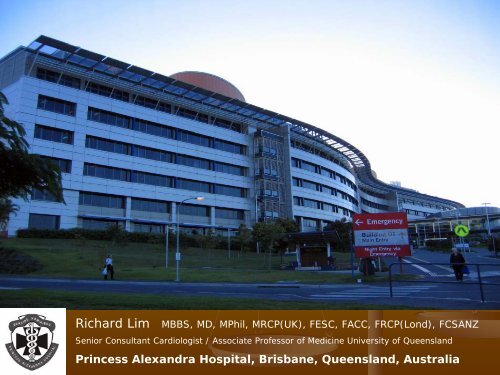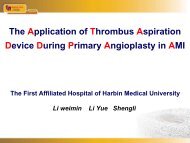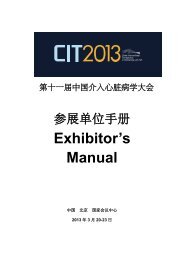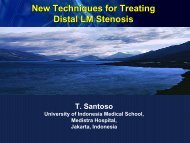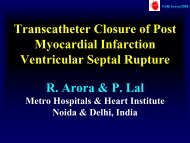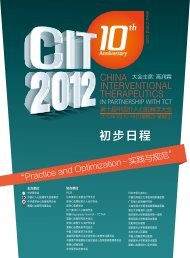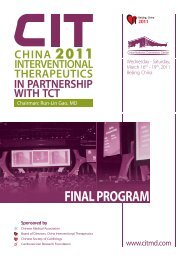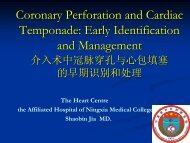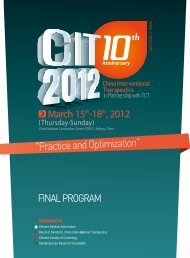Princess Alexandra Hospital, Brisbane, Queensland, Australia
Princess Alexandra Hospital, Brisbane, Queensland, Australia
Princess Alexandra Hospital, Brisbane, Queensland, Australia
Create successful ePaper yourself
Turn your PDF publications into a flip-book with our unique Google optimized e-Paper software.
Richard LimMBBS, MD, MPhil, MRCP(UK), FESC, FACC, FRCP(Lond), FCSANZSenior Consultant Cardiologist / Associate Professor of Medicine University of <strong>Queensland</strong><strong>Princess</strong> <strong>Alexandra</strong> <strong>Hospital</strong>, <strong>Brisbane</strong>, <strong>Queensland</strong>, <strong>Australia</strong>
Do ACS Risk Scores Work in Clinical Practice?Do ACS Risk Scores Work in Clinical Practice?CIT March 2008, Beijing
Prognosis in Acute Coronary Syndrome• Prognostic assessment is risky business• ACS a heterogeneous dynamic spectrum• Many reasonable ways to manage an individualbut only one wrong way• Potential benefit of treatment vs potential risk oftreatment• Not all high-risk patients can be helped or saved
Prognosis in Acute Coronary Syndrome• Prognostic assessment is risky business• ACS a heterogeneous dynamic spectrum• Several reasonable options to manage anindividual but only one wrong way• Potential benefit of treatment vs potential risk oftreatment• Not all high-risk patients can be helped or saved
Prognosis in Acute Coronary Syndrome• Prognostic assessment is risky business• ACS a heterogeneous dynamic spectrum• Many reasonable ways to manage an individualbut only one wrong way• Potential benefit of treatment vs potentialrisk of treatment• Not all high-risk patients can be helped or saved
Prognosis in Acute Coronary Syndrome• Prognostic assessment is risky business• ACS a heterogenous dynamic spectrum• Many reasonable ways to manage an individualbut only one wrong way• Potential benefit of treatment vs potential risk oftreatment• Not all high-risk patients can be helped orsaved
What Are ACS Risk Scores For?• In general, to estimate mortality riskgradient before cathBUT• Usefulness in real world practice dependson the specific reason for estimating risk
What Are ACS Risk Scores For?• To counsel patients andrelatives about risk estimateand rationale for management
What Are ACS Risk Scores For?• To select low risk patients forearly discharge
What Are ACS Risk Scores For?• In theory, to select higher riskpatients for early (within 30 days)or same-admission admission (in-hospital)cath +/- revascularisation
What Are ACS Risk Scores For?• In theory, to select higher riskpatients for early transfer tocath lab facility
Popular ACS Risk ScoresTIMI - STEMI (Circulation 2000)• Derived from InTIME II trial of nPA• n = 14 114• Primary end-point 30-d d mortality6.7%• 91% of deaths occurred in-hospital
Risk Score & Gradient
LimitationsTIMI - STEMI Risk Score• 80% had mortality risk better than orsimilar to primary end-point 30-daymortality of 6.7%• 91% of deaths occurred in-hospitalhospital• Hopefully the highest risk patients areclinically obvious!• RS not as discriminating ( (c = 0.65) inpatients not receiving lysis or PCI
Popular ACS Risk ScoresTIMI - NSTEACS (JAMA 2000)• TIMI 11B and ESSENCE• n = 7 081• Composite end-point 14-d d mortality / MI /severe ischaemia prompting urgentrevascularisation (16.7%)• 75% of events occurred in hospital• Mortality ranged from 1 to 6.5%
@ 14 daysRisk Score & Gradient
Yan et al. Eur Heart J 2007; 28: 1072-8
Yan et al. Eur Heart J 2007; 28: 1072-8
Popular ACS Risk ScoresGRACE – STEMI / NSTEACS• <strong>Hospital</strong> set (Arch Intern Med 2003)• n = 11 389 Apr 1999 – Mar 2002• 4.6 % in-hospital mortality• Median time of death 4 days• 21.9% of deaths within 24 hrs• Post-Discharge set (JAMA 2004)• n = 15 007 Apr 1999 – Mar 2002• 4.8 % mortality post-discharge to 6 mths
Worst Case Scenario• 90 yr old man• Chest pain for 11 ? 12 hrs• Cardiogenic shock; SBP 80• Serum creatinine 4 mg/dL• Precordial ST depression• VF arrest, then AF with VR response 200• Acute pulmonary oedema• Unresponsive
Worst Case Scenario (contd)• Intubated, , ventilated during CPR• CK already 1800 IU/L; troponin 10• Cognitive impairment; CVA 1 yr ago• Nursing home• Failed PCI 3 yrs ago (failed radial access; poorfemorals; ; +++diseased tortuous iliacs; ; poorguide cath support; +++calcified tortuous tightLAD/Cxlesions + occluded RCA; LVEF 30%)
372
Expected GRACE in-hospital mortality > 52%!!What to do?• Enoxaparin?• Tirofiban?• Urgent cath?• Urgent transfer to cath lab facility?NO!NO!!NO!!!Thanks but No Thanks!
Hypothetical• Young man (1 kid 4 yr old) 2 days before 40 thbirthday; <strong>Hospital</strong> business manager• 6-hr history of typical chest pain• SBP 90• SaO2 88% on 2L/min O2• Complete heart block; VR 40 bpm• ST elevation I, aVL, , V2 – 6 + ST depression III,aVF• CK 200; insufficient blood for troponin
GRACE 4.6%129
Wind Back the by 4 hrs
Hypothetical (contd)• 39 yr old man (2 days to 40)• 15 min typical chest pain 2 hr ago• SBP 168 HR 88• Anterior T wave inversion V2 - 3• CK normal; troponin not detectable• Now pain free• Declines admission
4.6%28
4.8%4.8%Max 263
Can ACS Risk ScoresPredict Coronary Anatomy?
PRISM-PLUS: TIMI score & Cath within 4 days (n=1491)Mega et al. Am Heart J 2005; 149: 846-50
Do Risk Scores Help to SelectPatients who will do Better afterRevascularisation ?
TIMI, PURSUIT & GRACE risk scores in NSTEACSGoncalves et al. Eur Heart J 2005; 26: 865-72
Do ACS Risk ScoresActually PredictRevascularisation?The Treatment-Risk Paradox
Intervention in acute coronary syndromes: do patientsundergo intervention on the basis of their riskcharacteristics? GRACE Fox et al. Heart 2007: 93: 177-82
Yan et al. Eur Heart J 2007; 28: 1072-8
Conclusions• Risk assessment should consider not onlythe risk of ACS itself but also the inherentrisk of invasive management vs thepotential to benefit.• Risk may be high in some patients, butthere may be little that can be done toreduce that risk.
Conclusions• Some patients at highest risk of death maynot be suitable for invasive management.• We need to help our non-interventionalcolleagues identify these, since they arethe most likely users of Risk Scores.
Conclusions• Some patients at highest risk of death maynot benefit from invasive management.• The challenge is for the interventionalcardiologist to acknowledge these.
Conclusions• Use of Risk Scores results in treatment-riskmismatch where there appears to be an inverserelationship between mortality risk and likelihoodof invasive management.• Global risk assessment by the clinician isinfluenced more by perceived appropriatenessof invasive management than any estimate ofdeath per se, leading to pragmatic flow-throughdecision-making.
Conclusions• No perfect ACS risk scoring system that capturesall pertinent factors which impact on prognosisand decision-making.• Common inherent limitation is trade-off betweenaccuracy and complexity• EBM should be Evidence and Experience BM


